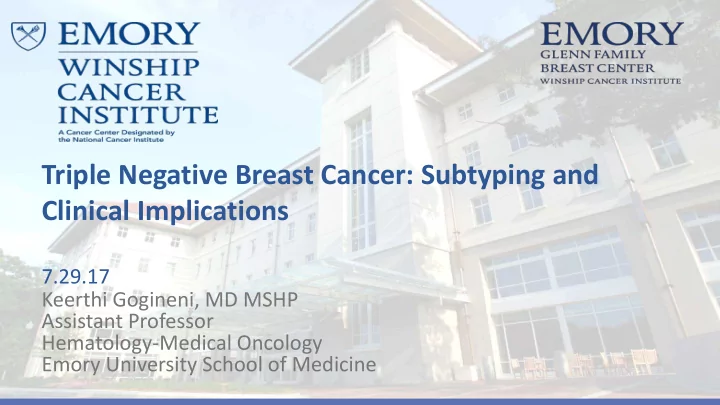

Triple Negative Breast Cancer: Subtyping and Clinical Implications 7.29.17 Keerthi Gogineni, MD MSHP Assistant Professor Hematology-Medical Oncology Emory University School of Medicine
BREAST CANCER SUBTYPES: IMMUNOHISTOCHEMISTRY GENE EXPRESSION PROFILING
TNBC: IHC Classification • Lacks all three predictive and prognostic IHC biomarkers (ER, PR, and Her2) • 15% of all breast cancers • Higher grade tumors and more advanced stage at presentation • Younger patients • African American patients Rivenbark et al. 2013. Am J Pathol.
TNBC: Early Recurrence Distant Recurrence Dent et al. Clin Cancer Res. 2007.
TNBC: Higher Mortality Dent et al. Clin Cancer Res. 2007.
Perou et al. Nature. 2000.
Breast Cancer Intrinsic Subtypes Carey et al. JAMA. 2006.
Mammary Epithelial Development & Intrinsic Subtypes Prat & Perou. Nat Medicine. 2009.
Receptor Profiles in Different Molecular Subtypes Kadoo et al. Cancer Treat Rev. 2012.
Basal-like Subtype and ER/PR Status Cheang et al. Oncologist. 2015.
Basal-Like: Mostly TN Perou. The Oncologist. 2010.
Claudin-Low: Mostly TN Perou. The Oncologist. 2010.
Her2-Enriched: Some TN Perou. The Oncologist. 2010.
2011: Intrinsic TNBC subtypes (6) Lehmann & Bauer et al. J Clin Invest. 2011.
2013: Intrinsic TNBC subtypes (4) Lehmann et al. PloS ONE. 2016.
Can You Order Intrinsic Subtype Testing? • PAM50-based Prosigna breast cancer gene signature assay – RNA from FFPE samples • BluePrint – Does not distinguish Luminal A from Luminal B – Genes profiled were selected based on concordance with IHC • No commercial assay (yet) to identify intrinsic TNBC subtypes identified by Lehmann
PAM50 & TNBC subtypes Correlation TNBC (6) % TNBC (4) % PAM50 BL1 18 35 Basal-Like BL2 11 22 Basal-Like IM 21 X M 21 25 Basal-Like MSL 8 X LAR 9 16 Enriched in Her2 and Luminal Lehmann et al. PloS ONE. 2016.
Poor Man’s Assay: IHC Surrogates for Molecular Classification Tang et al. Arch Pathol Lab Med. 2016.
BREAST CANCER SUBTYPES: PRESENTATIONS & CLINICAL OUTCOMES
Histology & Molecular Subtype All Breast Cancers PAM50 TNBC TNBC Type-4 8801 781 Histologic Subtype Molecular Subtype Molecular Subtype Ductal 6899 693 (10) BL1 Lobular 875 Luminal 18 (2.1) LAR Mucinous 147 Luminal 1 (0.7) Cribriform 251 1(0.4) Medullary 8 Basal-Like 4 (50) BL1, BL2, LAR Montagna et al. Clinical Breast Cancer. 2013. Other 5 2 (40) Ductal + Lobular 341 2 (0.6) Lehmann et al. PloS ONE. 2016. Tubular 84 Luminal 1 (1.2) Apocrine 72 29 (40.3) Papillary 45 9 (20) Tubulolobular 30 - Adenoid Cystic 11 Basal-Like 10 (90.9) Metaplastic 13 Basal-Like 10 (76.9) BL2 or M Micropapillary 20 1 (5)
Intrinsic Subtypes, Race, & Age Carey et al. JAMA. 2006.
Intrinsic Subtypes and Survival Luminal A Luminal B Claudin Low Basal Like Her2 Enriched Kadoo et al. Cancer Treat Rev. 2012.
TNBC Intrinsic Subtypes and Survival Proportion of patients surviving Days Masuda et al. Clin Cancer Res. 2014. Lehmann et al. PloS ONE. 2016.
TNBC Intrinsic Subtypes and pCR Masuda et al. Clin Cancer Res. 2014.
Response to Neoadjuvant AC/T Lehmann et al. PloS ONE. 2016.
TRIPLE NEGATIVE BREAST CANCER SUBTYPES: THERAPEUTIC TARGETS
Alignment of Therapy with Intrinsic TNBC Subtypes Abramson et al. Cancer. 2015.
TNBC SUBTYPE: BASAL-LIKE 1 • Cell cycle & DNA damage response signatures • Preferential response to platinum salts • Cells deficient in homologous recombination repair d/t BRCA mutations even more sensitive to platinum • BRCA mutated cancers enhanced sensitivity to PARP inhibition • PI3K inhibition to sensitize sporadic cancers to PARP inhibition or platinum salts
TNBC SUBTYPE: BASAL-LIKE 2 • Signature enriched for growth factor signaling and myoepithelial markers • Disappointing results with EGFR inhibition (cetuximab), modestly better when combined with platinum • Effect diluted by heterogeneity?
Basal-Like TNBC Subtype Xenograft Lehmann & Bauer et al. J Clin Invest. 2011.
MESENCHYMAL • Enriched for differentiation and growth factor pathways • Sensitivity to PI3K pathway inhibitors • Sensitivity to SRK inhibitors (dasatinib)
Mesenchymal TNBC Subtype Xenograft Lehmann & Bauer et al. J Clin Invest. 2011.
Luminal Androgen Receptor (LAR) • Driven by androgen signaling • High frequency of mutations in PIK3CA • Sensitivity to androgen antagonists (bicalutamide, enzalutamide) • Sensitivity to PI3K pathway inhibitors • Least sensitive to chemo
LAR TNBC Subtype Xenograft Lehmann & Bauer et al. J Clin Invest. 2011.
Therapeutic Approaches to TNBC Strategy Drugs Trials Cytotoxic nab-Paclitaxel + carboplatin tnppAcity Carboplatin TNT Defective DNA Repair Olaparib OlympiAD Niraparib BRAVO Talazoparib EMBRACA Checkpoint inhibition Pembroluzimab +/- chemo KEYNOTE-086, 119, 355 I-SPY 2 Atezolizumab +/- nab-Pac IMpassion130 Androgen Receptor Blockade Abiraterone UCBG 12-1 Enzalutamide ENZA Paclitaxel + Enzalutamide ENDEAR Antibody-Drug Conjugates IMMU-132 NCT02574455 CDX-011 METRIC PI3K/AKT/mTOR pathway AKT inhibitors + chemo I-SPY 2, LOTUS Antiandrogens + PI3K inhibitors
Molecular Subtyping/GEP Tomorrow • Golden Snitch: Personalized medicine • Profile signatures in residual disease and dormant cells for prognosis & treatment • Characterization of tissue tropism to enable tailored surveillance for metastatic disease
Molecular Subtyping/GEP Today • Prognostic for recurrence & survival and predictive of pCR • Primary utility in the clinic is to aid decisions about need for chemotherapy in Luminal A tumors • Triple negative subtyping not currently available or clinically actionable outside of a trial setting • Primary utility in research is to enable smarter clinical trial design & enrich trials for eligible subgroups
Thank you!
Recommend
More recommend